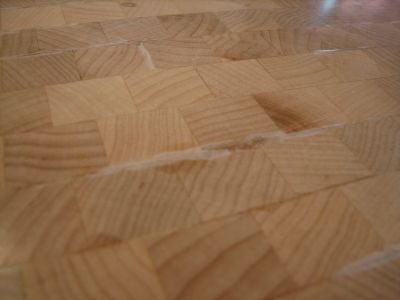Question
I finished an end grain maple butcher block counter-top. I used an Olympic water-based polyurethane. I sprayed the finish directly over the raw maple and everything looked great when I was done. Now it's six months later and as you can see from the picture, the finish is lifting at the joints.
I will refinish the piece but I want to understand the problem before I do this again. Do you think the problem is adhesion, lack of flexibility (i.e. too brittle of a finish) or some combination of both?
My requirements for a finish are that whatever is chosen imparts no color onto the wood and that it is durable enough to withstand normal wear and tear as an island counter-top. The butcher block is not used for cutting - it is decorative only.
I am thinking about trying out Target's 9300 Polycarbonate finish. Does anyone have any thoughts?
 height=300 border=0>
height=300 border=0>Forum Responses
(Finishing Forum)
From contributor G:
Looks like glue from here. Is that the top or bottom of the block?
To contributor J: What kind of finish does spoon oil leave? It was important on this project for the block to have a satin to semi-gloss sheen to it. The homeowner didn't want a flat finish like a working BB would have. I was also concerned about an oil finish ambering the overall color of the block.
You have to work quick with Kwik-Poly and sometimes split up the area a bit but use it as a wipe on (you can pour it on but spread it quickly and wipe off the excess before it hardens) and do two or three coats and then you can sand to the sheen you want or coat over it with whatever you like (I'd recommend Clear Satin Breakthrough).
If at all possible you should also finish the bottom of the BB counter in a similar manner as otherwise moisture from the air might cause problems. This type of assembly is exceptionally vulnerable to movement problems. You need every edge you can get. Also be sure to get all that moisture out of the wood before refinishing.
It is important to minimize the exchange of moisture with the environment by first finishing the bottom as well as the top and second minimizing humidity changes in the environment itself if possible. Is there a dish washer in the area? They pump out a lot of humidity when the dry cycle is used.